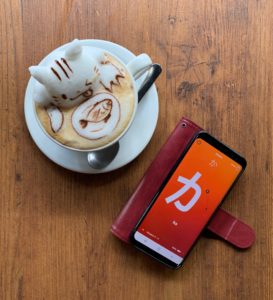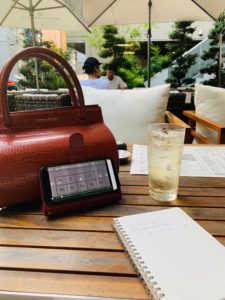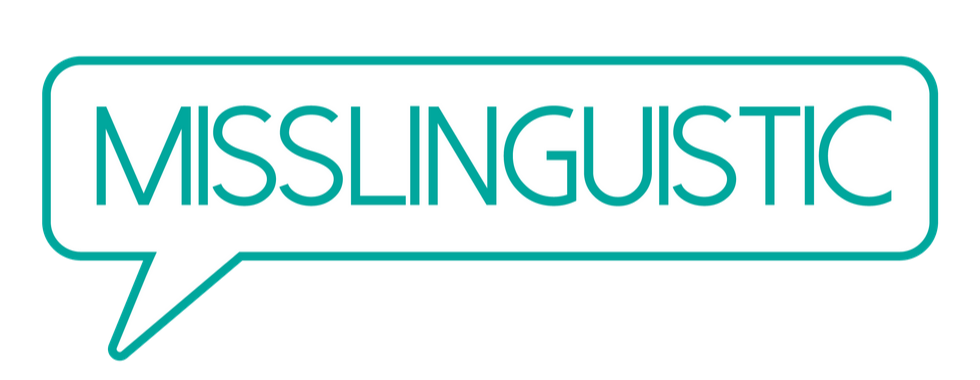Self-Study Starter Kit: Japanese
I’ve been to Japan many times now, but for some reason I always resisted learning Japanese. I suppose part of me was worried it would interfere with my Korean. Maybe a more truthful part of me was worried I would get obsessed (as I often do) and end up neglecting everything else I’m really supposed to be working on!
So yeah…that happened.
On my most recent trip to Tokyo I spent much longer than usual – three whole weeks! And I already know I’ll be back in Japan for the Polyglot Conference in Fukuoka. So these factors conspired to finally encourage me to learn a little basic Japanese.
If you already speak Chinese and/or Korean…wow. This is a really fun language to learn. A lot of the vocabulary Is shared with Chinese (more than I expected) and the grammar is essentially the same as Korean (so far).
I don’t expect to get very far with Japanese this year, I’m really just doing this for fun to get a overall sense of the structure and the sounds of the language, and to have some basic phrases ready for travel. But with the wealth of resources available online, I was very well-supported in my mini-quest.
Here’s what worked for me!
Getting Started: An Overview of the Language
I’m a very top-down learner: I need to have a good understanding of the big picture before I can dive into the details. For this reason I love to skim some kind of grammatical overview of a language before getting started with the details.
Written by the host of the excellent podcast, LanguageMastery, this opus zooms out to show you the big picture of the Japanese language, before zooming in on the details.
I found the included “How Japanese Works” pdf to be particularly helpful. This book is also a wealth of knowledge when it comes to generalizable language-learning tips, ranging from motivation to memory tricks, even optimizing your nutrition for maximum brain performance!
Olly Richards' Japanese Uncovered
Olly Richards teaches languages through stories - a top-down method that I like to recommend to beginners, because you don't get lost in the WHY of multiple conjugations and grammar patterns. When you learn bottom-up (starting with conjugations, with pronunciation, etc.) your brain often doesn't know what information is important and what is just noise. This can make it really hard for beginners to get initial traction. Starting with the bigger picture (for example, a story) helps you set your linguistic priorities.
This course only just launched (in October 2019) so I've just had the chance to try out the first couple lessons. So far, I'm finding it very useful!
Phrasebooks for language learning? It may sound silly, but actually the introductory section of phrasebooks (where they explain the most important grammatical rules, such as word order, plurals, etc.) can be a really good way to get your first grasp of how a language works. And while you’re traveling, the actual phrases really do come in handy! I find phrasebooks much more useful than GoogleTranslate if I'm traveling to a country where I don't speak the language.
Reading and Writing (Hirigana, Katakana, and Kanji)
Japanese uses three writing systems (in conjunction) to represent their language.
- Kanji (originally adapted from Chinese characters) which represent the “content words” (nouns, verb stems, and more).
- Kana (hiragana and katakana) which are syllabaries (similar to alphabets, but based on syllables instead of individual sounds) that represent the extra particles and grammatical conjugations.
Yay! I bet you were hoping you’d have to learn THREE SEPARATE SYSTEMS to be able to read a simple Japanese sentence. No? Well luckily there are quite a few apps and courses out there to guide you through. It took me about three weeks to learn the Kana (studying about 1 hour a day). Since the Kanji are very similar to simplified Chinese characters (and I’ve already studied Chinese for many years) they were less of a challenge for me, although I still don’t know how many of them are pronounced in Japanese (they’re very different from the Chinese pronunciations).
My advice? Don’t stick to one method. Reinforce what you learn as much as possible, using a variety of apps/methods. I did Drops in tandem with the Udemy Japanese course, but even once I finished both I still needed to do quite a bit of reinforcement with Wanikani and Lingodeer before I had really retained the kana.
(Free trial, then $9 a month or cheaper depending on your commitment)
Great app for learning to read and write kanji, which starts you off learning the “radicals” (smaller components of meaning that make up the kanji). While the interface is a bit clunky, the lessons themselves and the strategy is highly effective.
It starts with a free trial so that you can make sure it works for you. I don’t recommend trying to get the app to work (the instructions seem to be a bit out of date), just do it in your computer browser.
To start, go to Lessons, then Start session (I mentioned that this is clunky, getting started is not very intuitive but once you’re in you can get into a good flow!)
If you want more of an overview, I found this video to be helpful.

(Freemium model)
The very first program I used to learn to read and write Japanese was Drops – I love their interface. So aesthetically pleasing, so organized, so effectively gamified.
The only issue was that once I finished the Hiragana section…I still didn’t actually feel like I could accurately recognize all of the hiragana, let alone write them.
I ended up repeating the Hiragana section twice, and then supplementing with a few other resources here, before I felt like I had the Hiragana down.
At the time of writing, I’m on the second round of Katakana.
I still think Drops is very useful for learning the Japanese writing system! Just don’t get discouraged when you’ve completed a section and still don’t feel proficient…
I like pairing a session of Drops with an incredibly kawaii Japanese latte...
Attain Corp’s Online Japanese Beginner Course (on Udemy)

Since it is hosted on Udemy, pricing will vary, I bought it at about USD 11.
This course spends the bulk of its time teaching you to read, write, and pronounce hirigana and katakana.
To use this course, I sat in Japanese cafes with a notebook and pen and wrote out everything she demonstrated as many times as I could. I found it very helpful for stroke order and pronunciation.
It does not go much further beyond the writing system (it doesn’t get into any grammar) but I found it very useful for structuring my study time.
The nice thing about Udemy courses is you can download them onto your phone to playback regardless of whether you have wifi or not. So these are great for long airplane rides...or outdoor cafes.
Grammar and Structure
Genki Textbook
This was the first textbook recommended to me by my italki tutor, to form the structure of our studies. Nice and clear, and easy to follow.
Freemium Model, but definitely worth the perks.
Sign up for one of their long-term discounts and you'll barely be paying anything at all (and it will motivate you to keep up your learning!)
As always, I love these lessons (developed by Innovative Language Learning) because they’re comprehensive, extensive, and fun to listen to. The app is really easy to use, and you can find transcripts for each lesson and even make digital flash cards. Totally worth the (affordable) price tag.
The only annoying thing is that you can’t easily switch between languages in the app. You need to create a new account for each language you’re learning. But in the end, it has still been worth the hassle for me (11 accounts later…)
Free to use for writing and introductory courses, then between $1.25 to 4.99 per month depending on your commitment.
If you purchase the course, you can use referral code MISSLING for 15% off! To refeem, sign up on their website.
You can definitely tell that Lingodeer was designed with Asian languages in mind. Many other more mainstream apps (who shall not be named) started with European languages and assumed that they could teach Asian languages in the same way, and it doesn’t quite work. This app does not make that mistake.
Lingodeer guides you through the writing systems of Japanese and then into the grammar, and I found the grammar explanations to be so helpful and clear! Gamified apps like Duolingo and Rosetta Stone can be fun and all, but sometimes you just need to have the rules spelled out for you (especially when the languages you are learning are fundamentally different from English).
I also love that once you launch into the vocab and grammar lessons you can toggle between the writing systems (and choose to display or not display romanji, in case you still need some extra help with the writing system.
11.99 for the Start Course
This short course will take you through the very basics of Japanese grammar – how to form short simple sentences like “I eat sushi every day” (and these three weeks in Tokyo - TRUTH).
Whereas Pimsleur focuses on sentences you’ll need while you travel (regardless of and without explaining any grammar structures) Michel Thomas explains how the grammar works so that you can create novel sentences on your own.
The course is about an hour and a half of listening, although I circled back and listened to a few lessons more than once.
I listened to the whole course while doing a solo hike of Mt. Takao – I highly recommend doing Michel Thomas while you walk or do some other kind of not-too-strenuous exercise!
$23.99 for Unit 1-5
Similar to Michel Thomas, Pimsleur is an audio program you can listen to in your car or on long walks. It focuses on sentences you’ll need for travel and for interactions with native speakers and does not teach you reading or grammar rules.
Pimsleur is best used if you have quite a bit of runway before your trip, or want a technique that requires minimal active learning. It moves very slowly, but this also means you’ll retain the information for longer (as long as you do it consistently). I also like to do Pimsleur while I exercise or while doing menial tasks.
Tutors and Strategies
As always, I find italki to be one of the most foundational parts of my language study. You just can’t beat having a knowledgeable tutor guide you around the land mines (e.g. bad habits) and show you the right shortcuts to understanding.
Italki helps you schedule and stay accountable to your lessons (I love their timezone-friendly platform and reminder system) and they had SO many Japanese teachers to choose from. As usual, I went for a tutor who had taught at least 1,000 lessons and was a native speaker of Japanese.
For more tips on how to use italki efficiently, check out my blog post here.
You can read more about my monologue method here. For Japanese, since I’m here in Tokyo for work and knew I wouldn’t have too much time, I stuck to a very simple and short self-introduction. I found a translator on Upwork to translate and record it for me, then listened to it over and over for a few days while I navigated the Tokyo metro. Then I recorded it on my last day!
Will post my monologue soon!
Media
YouTube – Lindie Botes
I find this language blogger so inspiring, and I’m glad she is out there representing both 1) female polyglots and 2) Westerners learning Asian languages. Check out her Japanese videos here.
More Resources?
Want a more exhaustive list? I’ve only listed the resources that I’ve tried myself and found to be useful, but Lindie Botes has a more extensive list of Japanese resources here.
By the way, this post contains affiliate links. If you purchase a product using these links it doesn't cost any more for you (in fact, sometimes I've managed to get you a discount!) I also get a small commission on these purchases, which helps fund this blog. I only link to products that I have found to be helpful on my language learning journey, so I hope they're helpful for you as well!
Do you have any more recommendations, or comments about any of these resources? Leave your notes in the comments!



